Analysis of Xanthine Oxidase Inhibitors from Clerodendranthus spicatus with Xanthine Oxidase Immobilized Silica Coated Fe3O4 Nanoparticles
Abstract
:1. Introduction
2. Results and Discussion
2.1. Characterization of Fe3O4@SiO2-XO Nanoparticles
2.2. Optimization of Screening Conditions
2.3. Screening of XO Inhibitors from Clerodendranthus spicatus
2.4. Identification of Screened Potential XO Inhibitors
2.5. Inhibition on XO of Screened Potential XO Inhibitors
2.6. Fluorescent Quenching of Screened Compounds on XO
2.7. The Binding Constants and the Number of Binding Sites
3. Materials and Methods
3.1. Materials
3.2. Preparation of Ethanol Extract of Clerodendranthus spicatus
3.3. Preparation of Fe3O4@SiO2-XO Nanoparticles
3.4. Characterization of Fe3O4@SiO2-XO Nanoparticles
3.5. XO Activity and Inhibition Test
3.6. Screening of XO Inhibitors from Clerodendranthus spicatus
3.7. HPLC Analysis of Samples
3.8. Identification of the Screened Compounds
3.9. XO Fluorescence Quenching
4. Conclusions
Acknowledgments
Author Contributions
Conflicts of Interest
References
- Newman, D.J.; Cragg, G.M. Natural products as sources of new drugs over the 30 years from 1981 to 2010. J. Nat. Prod. 2012, 75, 311–335. [Google Scholar] [CrossRef] [PubMed]
- Li, J.W.H.; Vederas, J.C. Drug discovery and natural products: End of an era or an endless frontier? Science 2009, 325, 161–165. [Google Scholar] [CrossRef] [PubMed]
- Li, M.; Wang, S.; He, L. Development of an analytical method coupling cell membrane chromatography with gas chromatography—Mass spectrometry via microextraction by packed sorbent and its application in the screening of volatile active compounds in natural products. J. Chromatogr. B 2015, 974, 9–16. [Google Scholar] [CrossRef] [PubMed]
- Pardo, A.; Mespouille, L.; Dubois, P.; Duez, P.; Blankert, B. Targeted extraction of active compounds from natural products by molecularly imprinted polymers. Cent. Eur. J. Chem. 2012, 10, 751–765. [Google Scholar] [CrossRef]
- Tang, C.; Liu, Z.S.; Qin, N.; Xu, L.; Duan, H.Q. Novel cell membrane capillary chromatography for screening active compounds from natural products. Chromatographia 2013, 76, 697–701. [Google Scholar] [CrossRef]
- Moreira, M.; Moldes-Diz, Y.; Feijoo, S.; Eibes, G.; Lema, J.; Feijoo, G. Formulation of laccase nanobiocatalysts based on ionic and covalent interactions for the enhanced oxidation of phenolic compounds. Appl. Sci. 2017, 7, 851. [Google Scholar] [CrossRef]
- Neng, J.; Tan, J.; Jia, K.; Sun, P. A fast and cost-effective detection of melamine by surface enhanced raman spectroscopy using a novel hydrogen bonding-assisted supramolecular matrix and gold-coated magnetic nanoparticles. Appl. Sci. 2017, 7, 475. [Google Scholar] [CrossRef]
- McDermott, S.; Guimaraes, A.R. Magnetic nanoparticles in the imaging of tumor angiogenesis. Appl. Sci. 2012, 2, 525–534. [Google Scholar] [CrossRef]
- Liu, Y.; Yan, M.; Geng, Y.; Huang, J. Laccase immobilization on poly(p-phenylenediamine)/Fe3O4 nanocomposite for reactive blue 19 dye removal. Appl. Sci. 2016, 6, 232. [Google Scholar] [CrossRef]
- Wang, T.; Li, D.; Yu, B.; Qi, J. Screening inhibitors of xanthine oxidase from natural products using enzyme immobilized magnetic beads by high-performance liquid chromatography coupled with tandem mass spectrometry. J. Sep. Sci. 2017, 40, 1877–1886. [Google Scholar] [CrossRef] [PubMed]
- Tang, C.; Mao, R.; Liu, F.; Yu, Y.; Xu, L.; Zhang, Y. Ligand fishing with cellular membrane-coated magnetic beads: A new method for the screening of potentially active compounds from natural products. Chromatographia 2017, 80, 1517–1525. [Google Scholar] [CrossRef]
- Liu, D.M.; Chen, J.; Shi, Y.P. Screening of enzyme inhibitors from traditional chinese medicine by magnetic immobilized α-glucosidase coupled with capillary electrophoresis. Talanta 2017, 164, 548–555. [Google Scholar] [CrossRef] [PubMed]
- Qi, J.; Sun, L.Q.; Qian, S.Y.; Yu, B.Y. A novel multi-hyphenated analytical method to simultaneously determine xanthine oxidase inhibitors and superoxide anion scavengers in natural products. Anal. Chim. Acta 2017, 984, 124–133. [Google Scholar] [CrossRef] [PubMed]
- Zhang, H.J.; Hu, Y.J.; Xu, P.; Liang, W.Q.; Zhou, J.; Liu, P.G.; Cheng, L.; Pu, J.B. Screening of potential xanthine oxidase inhibitors in gnaphalium hypoleucum dc. By immobilized metal affinity chromatography and ultrafiltration-ultra performance liquid chromatography-mass spectrometry. Molecules 2016, 21, 1242. [Google Scholar] [CrossRef] [PubMed]
- Bove, M.; Cicero, A.F.G.; Borghi, C. The effect of xanthine oxidase inhibitors on blood pressure and renal function. Curr. Hypertens. Rep. 2017, 19, 95. [Google Scholar] [CrossRef] [PubMed]
- Ishii, T.; Taguri, M.; Tamura, K.; Oyama, K. Evaluation of the effectiveness of xanthine oxidoreductase inhibitors on haemodialysis patients using a marginal structural model. Sci. Rep. 2017, 7, 14004. [Google Scholar] [CrossRef] [PubMed]
- Zheng, Q.; Sun, Z.; Zhang, X.; Yuan, J.; Wu, H.; Yang, J.; Xu, X. Clerodendranoic acid, a new phenolic acid from clerodendranthus spicatus. Molecules 2012, 17, 13656–13661. [Google Scholar] [CrossRef] [PubMed]
- Sun, Z.; Zheng, Q.; Ma, G.; Zhang, X.; Yuan, J.; Wu, H.; Liu, H.; Yang, J.; Xu, X. Four new phenolic acids from clerodendranthus spicatus. Phytochem. Lett. 2014, 8, 16–21. [Google Scholar] [CrossRef]
- Ma, G.X.; Zhang, X.P.; Li, P.F.; Sun, Z.H.; Zhu, N.L.; Zhu, Y.D.; Yang, J.S.; Chen, D.L.; Wu, H.F.; Xu, X.D. Four new phenolic acid with unusual bicycle [2.2.2] octane moiety from clerodendranthus spicatus and their anti-inflammatory activity. Fitoterapia 2015, 105, 61–65. [Google Scholar] [CrossRef] [PubMed]
- Luo, Y.; Cheng, L.Z.; Luo, Q.; Yan, Y.M.; Wang, S.M.; Sun, Q.; Cheng, Y.X. New ursane-type triterpenoids from clerodendranthus spicatus. Fitoterapia 2017, 119, 69–74. [Google Scholar] [CrossRef] [PubMed]
- Li, Q.; He, Y.N.; Shi, X.W.; Kang, L.Y.; Niu, L.Y.; Wang, X.G.; Feng, W. Clerodens e–j, antibacterial caffeic acid derivatives from the aerial part of clerodendranthus spicatus. Fitoterapia 2016, 114, 110–114. [Google Scholar] [CrossRef] [PubMed]
- Sheng, W.; Wei, W.; Li, J.; Qi, X.; Zuo, G.; Chen, Q.; Pan, X.; Dong, W. Amine-functionalized magnetic mesoporous silica nanoparticles for DNA separation. Appl. Surf. Sci. 2016, 387, 1116–1124. [Google Scholar] [CrossRef]
- Liu, L.; Leng, J.; Yang, X.; Liao, L.; Cen, Y.; Xiao, A.; Ma, L. Rapid screening and identification of bsa bound ligands from radix astragali using bsa immobilized magnetic nanoparticles coupled with hplc-ms. Molecules 2016, 21, 1471. [Google Scholar] [CrossRef] [PubMed]
- Tian, Z.; Yu, X.; Ruan, Z.; Zhu, M.; Zhu, Y.; Hanagata, N. Magnetic mesoporous silica nanoparticles coated with thermo-responsive copolymer for potential chemo- and magnetic hyperthermia therapy. Microporous Microporous Mater. 2018, 256, 1–9. [Google Scholar] [CrossRef]
- Al-Dhrub, A.H.A.; Sahin, S.; Ozmen, I.; Tunca, E.; Bulbul, M. Immobilization and characterization of human carbonic anhydrase i on amine functionalized magnetic nanoparticles. Process Biochem. 2017, 57, 95–104. [Google Scholar] [CrossRef]
- Maurya, P.; Singh, S.; Gupta, M.M.; Luqman, S. Characterization of bioactive constituents from the gum resin of gardenia lucida and its pharmacological potential. Biomed. Pharmacother. 2017, 85, 444–456. [Google Scholar] [CrossRef] [PubMed]
- Akowuah, G.A.; Zhari, I.; Norhayati, I.; Sadikun, A.; Khamsah, S.M. Sinensetin, eupatorin, 3′-hydroxy-5, 6, 7, 4′-tetramethoxyflavone and rosmarinic acid contents and antioxidative effect of orthosiphon stamineus from malaysia. Food Chem. 2004, 87, 559–566. [Google Scholar] [CrossRef]
- Tuzun, B.S.; Hajdu, Z.; Orban-Gyapai, O.; Zomborszki, Z.P.; Jedlinszki, N.; Forgo, P.; Kivcak, B.; Hohmann, J. Isolation of chemical constituents of centaurea virgata lam. And xanthine oxidase inhibitory activity of the plant extract and compounds. Med. Chem. 2017, 13, 498–502. [Google Scholar] [CrossRef] [PubMed]
- Li, S.; Tang, L.; Bi, H. Study on the interaction between pelargonidin-3-o-glucoside and bovine serum albumin using spectroscopic, transmission electron microscopy and molecular modeling techniques. Luminescence 2016, 31, 442–452. [Google Scholar] [CrossRef] [PubMed]
- Xiao, J.; Cao, H.; Wang, Y.; Yamamoto, K.; Wei, X. Structure–affinity relationship of flavones on binding to serum albumins: Effect of hydroxyl groups on ring A. Mol. Nutr. Food Res. 2010, 54, S253–S260. [Google Scholar] [CrossRef] [PubMed]
- Chen, J.; Leng, J.; Yang, X.; Liao, L.; Liu, L.; Xiao, A. Enhanced performance of magnetic graphene oxide-immobilized laccase and its application for the decolorization of dyes. Molecules 2017, 22, 221. [Google Scholar] [CrossRef] [PubMed]
- Liu, L.; Xiao, A.; Ma, L.; Li, D.; Liu, L.; Xiao, A.; Ma, L.; Li, D. Analysis of xanthine oxidase inhibitors from puerariae flos using centrifugal ultrafiltration coupled with hplc-ms. J. Braz. Chem. Soc. 2016, 28, 360–366. [Google Scholar]
- Liu, L.; Shi, S.; Zhao, H.; Yu, J.; Jiang, X.; Chen, X. Selective fishing and analysis of xanthine oxidase binders from two fabaceae species by coupling enzyme functionalized core–shell magnetic nanoparticles with hplc–ms. J. Chromatogr. B 2014, 945–946, 163–170. [Google Scholar] [CrossRef] [PubMed]
- Xiao, J.; Kai, G.; Ni, X.; Yang, F.; Chen, X. Interaction of natural polyphenols with [small alpha]-amylase in vitro: Molecular property-affinity relationship aspect. Mol. BioSyst. 2011, 7, 1883–1890. [Google Scholar] [CrossRef] [PubMed]
- Xiao, J.; Zhao, Y.; Wang, H.; Yuan, Y.; Yang, F.; Zhang, C.; Yamamoto, K. Noncovalent interaction of dietary polyphenols with common human plasma proteins. J. Agric. Food Chem. 2011, 59, 10747–10754. [Google Scholar] [CrossRef] [PubMed]

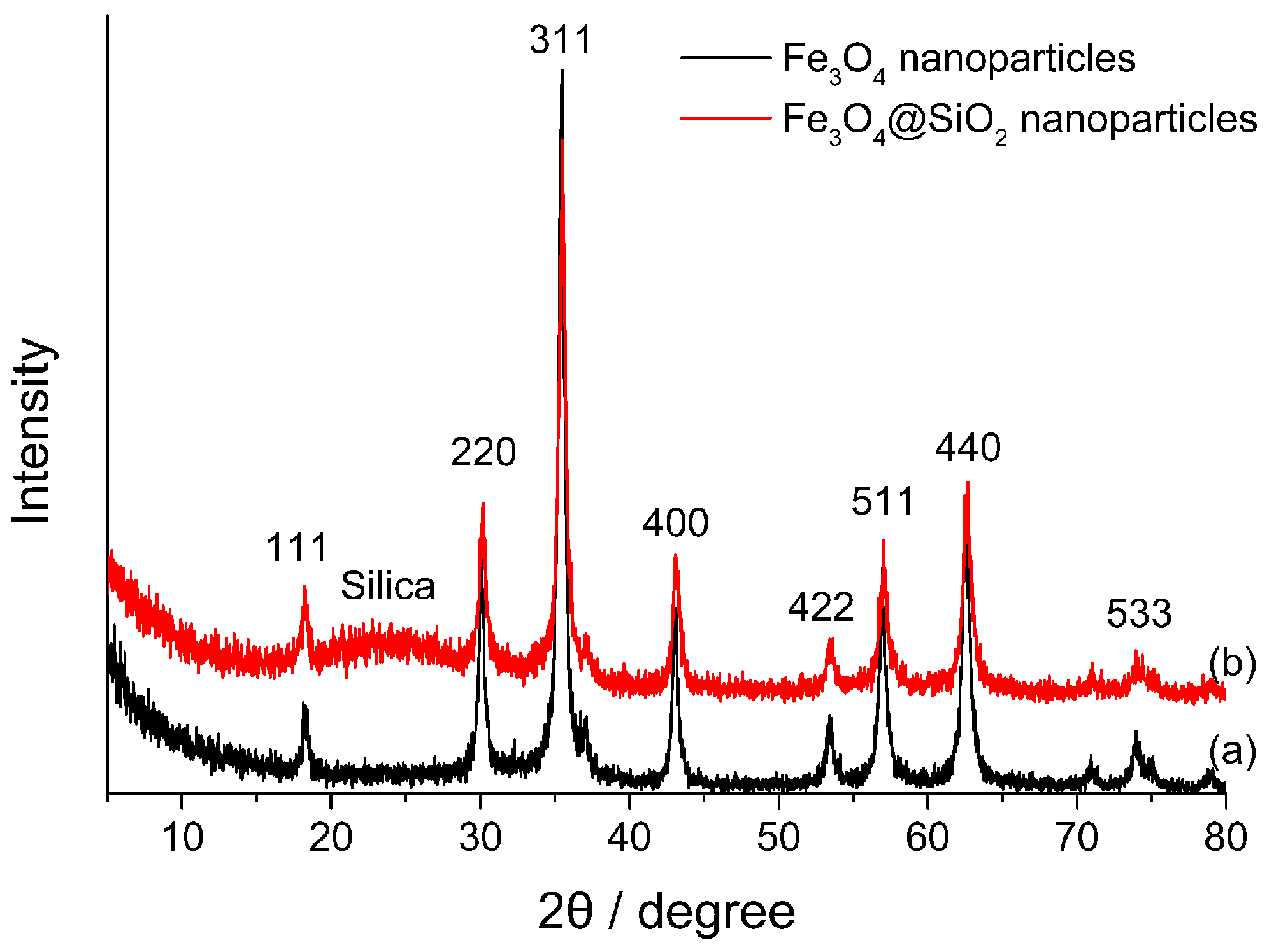
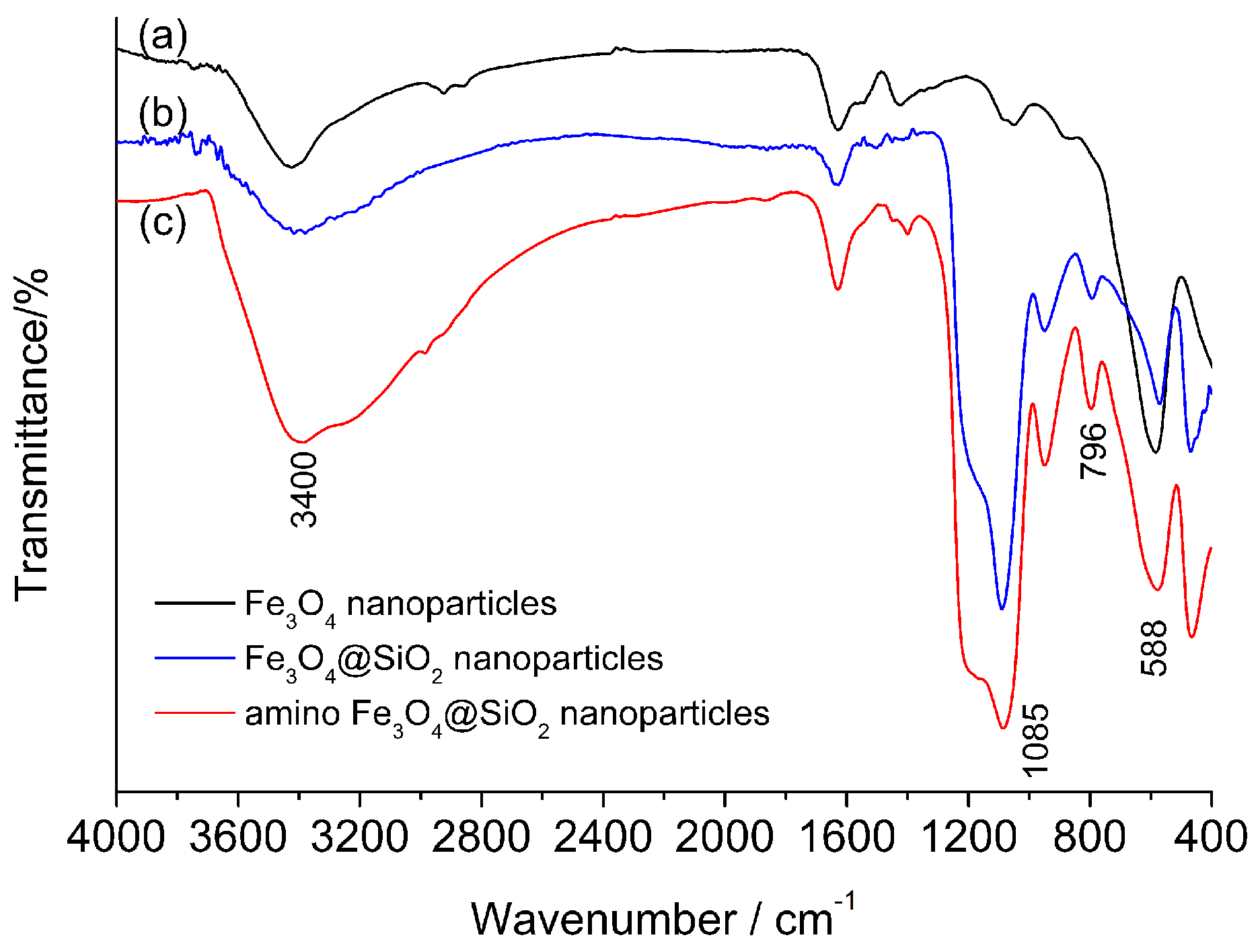

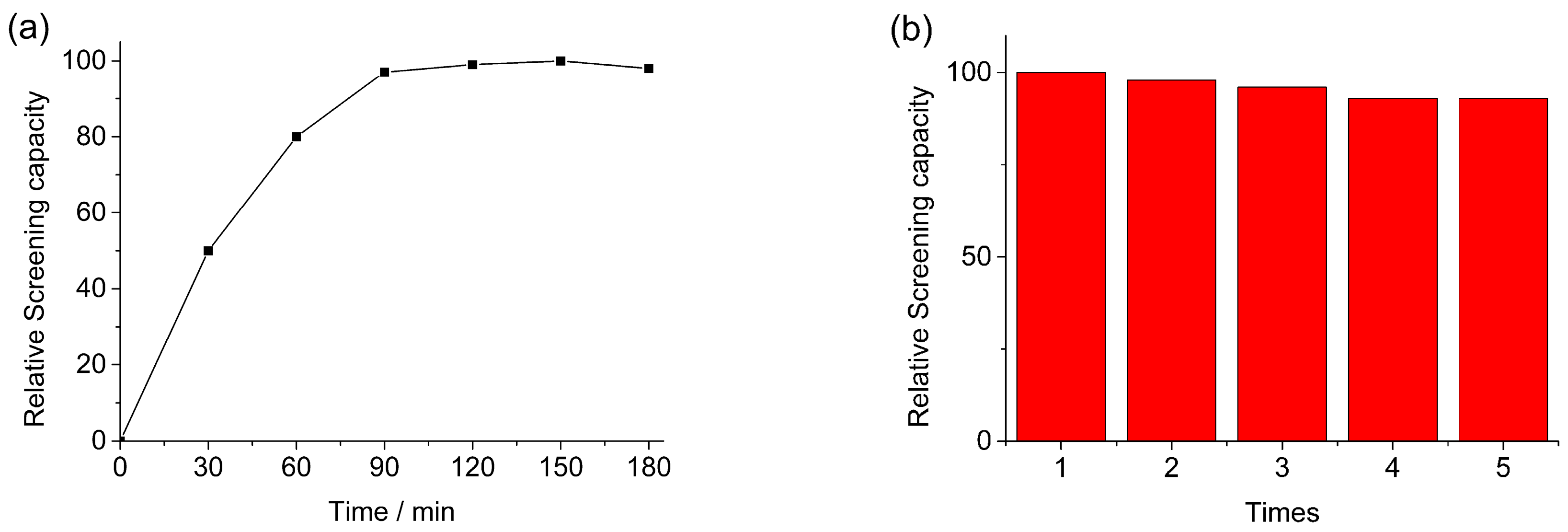
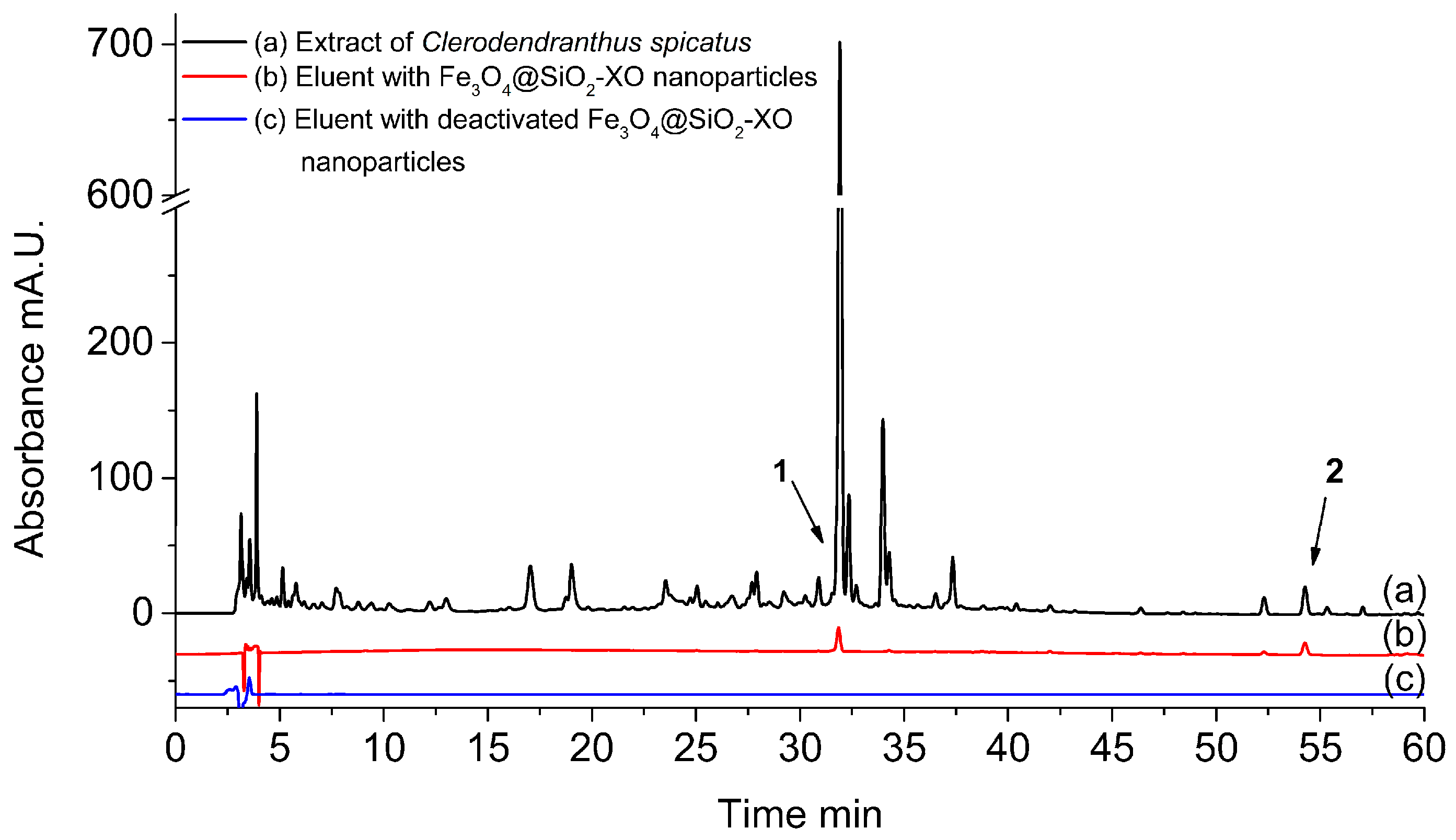
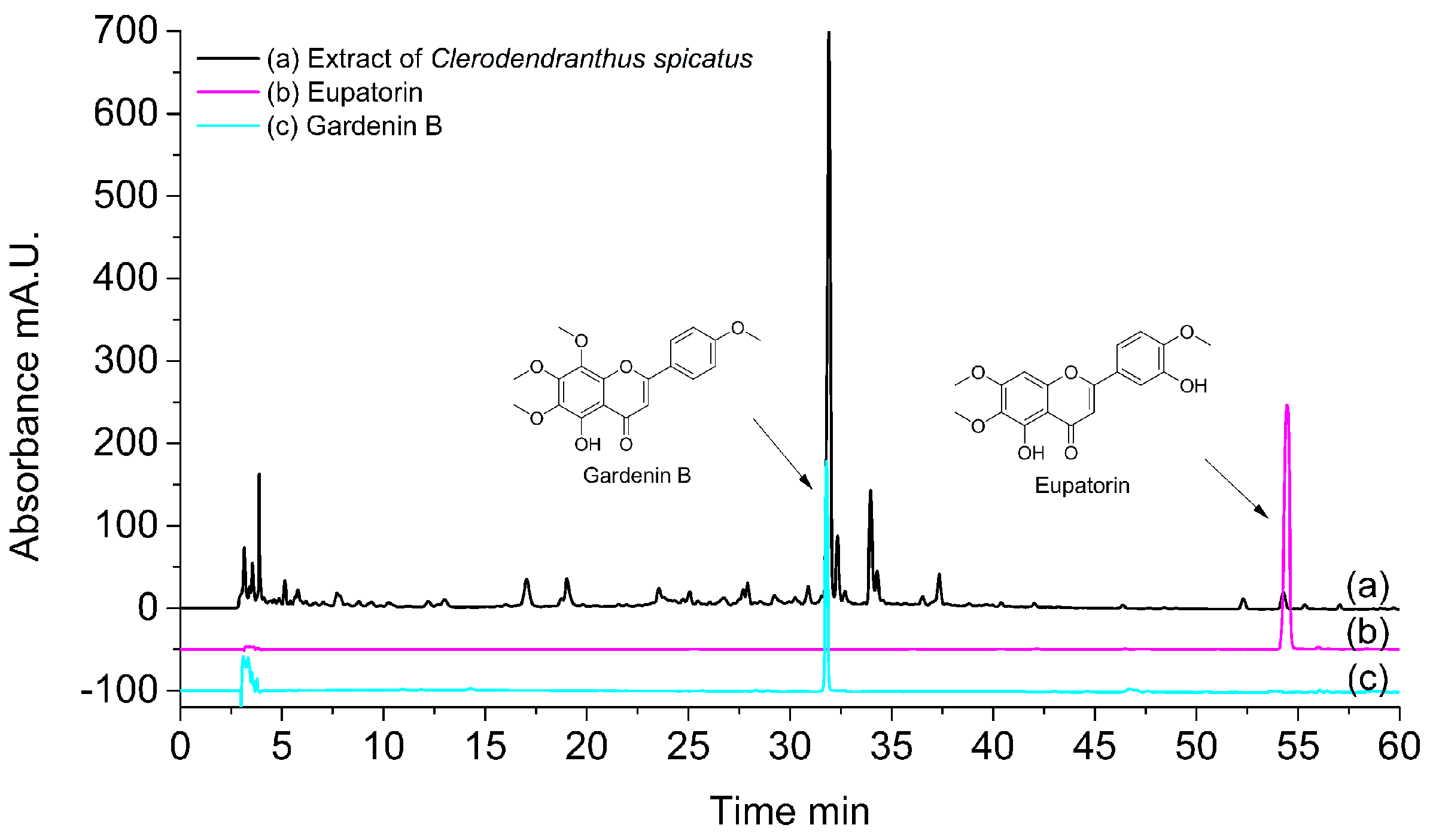
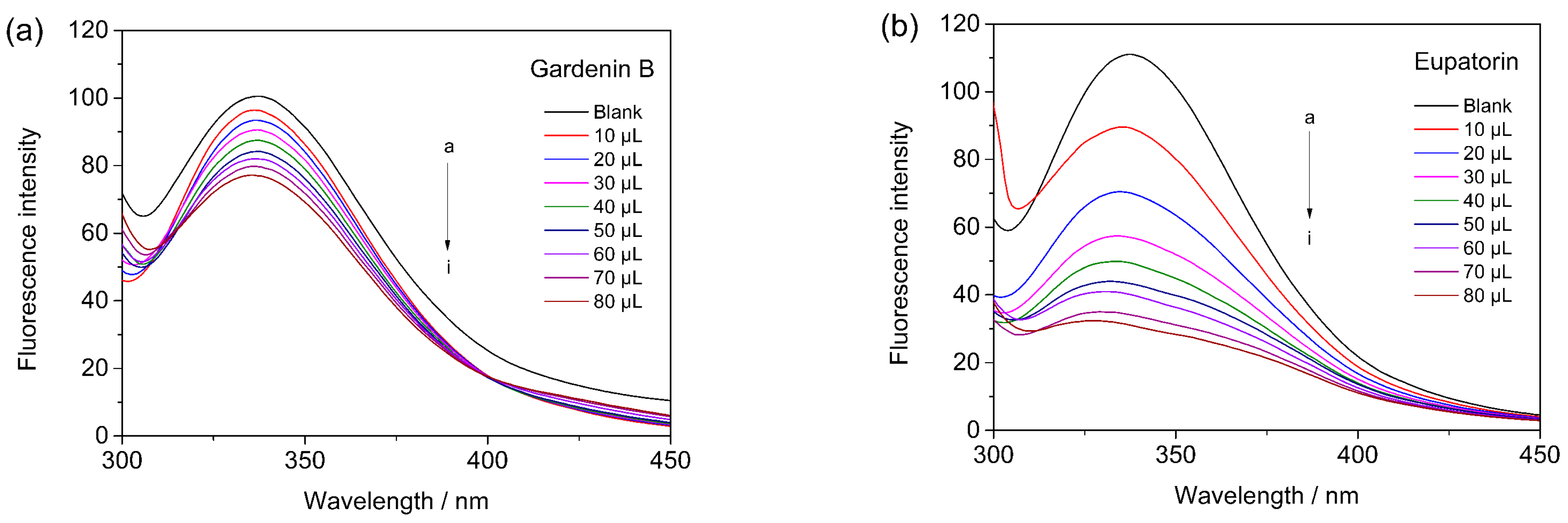
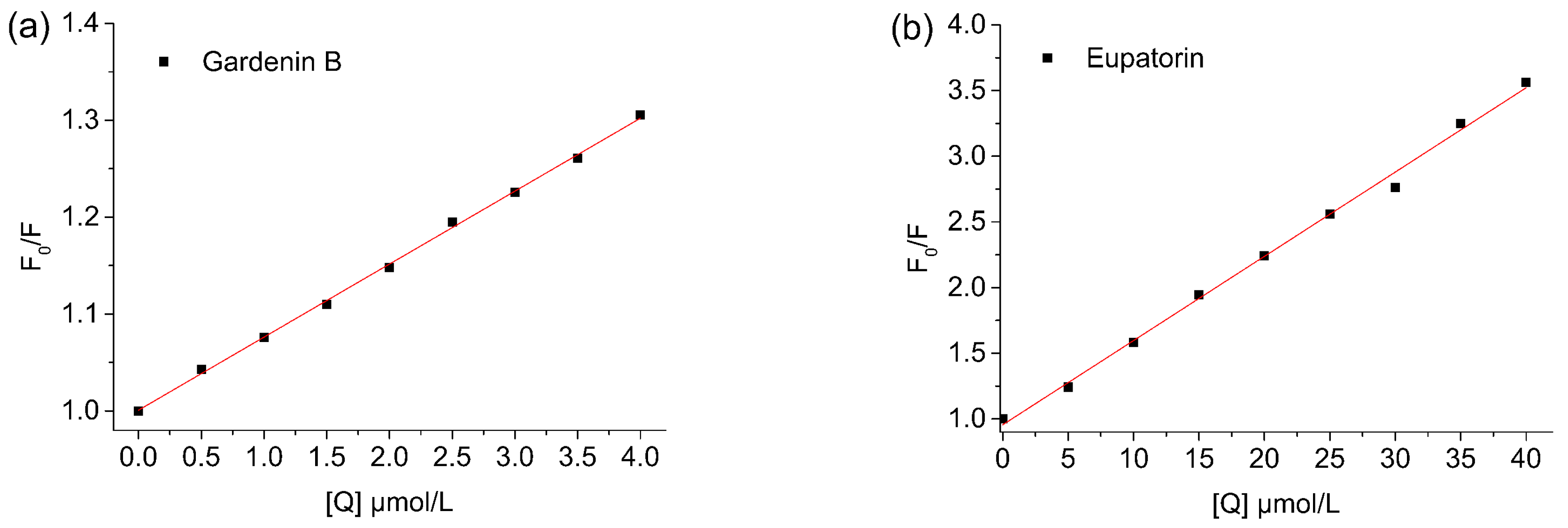
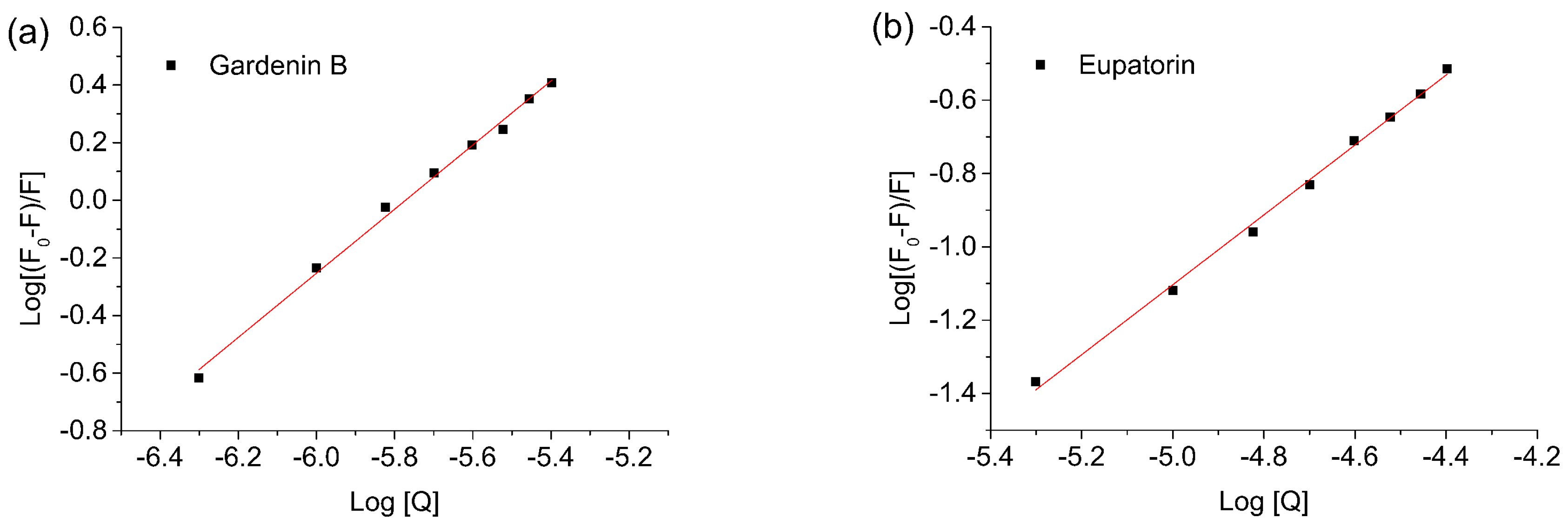
| No. | Identification | Retention Time (min) | Molecular Weight | Proposed Ions (m/z) | Ultraviolet Spectrum λmax (nm) | |
|---|---|---|---|---|---|---|
| 1 | Gardenin B | 31.90 | 358 | [M − H]− | 357 | 280, 330 |
| [2M − H]− | 715 | |||||
| 2 | Eupatorin | 54.28 | 344 | [M − H]− | 343 | 250, 275, 340 |
| [2M − H]− | 687 | |||||
| [M + H]+ | 345 | |||||
| [2M + Na]+ | 711 | |||||
| No. | Compounds | Kq (1013) | Ksv (105) | R2 | Log10Ka | n | R2 |
|---|---|---|---|---|---|---|---|
| 1 | Gardenin B | 1.2194 | 0.7560 | 0.9988 | 6.4209 | 1.1124 | 0.9950 |
| 2 | Eupatorin | 1.0097 | 0.6260 | 0.9957 | 3.6639 | 0.9534 | 0.9962 |
© 2018 by the authors. Licensee MDPI, Basel, Switzerland. This article is an open access article distributed under the terms and conditions of the Creative Commons Attribution (CC BY) license (http://creativecommons.org/licenses/by/4.0/).
Share and Cite
Liu, L.; Yuan, M.; Huang, S.; Li, J.; Li, D.; Zhao, L. Analysis of Xanthine Oxidase Inhibitors from Clerodendranthus spicatus with Xanthine Oxidase Immobilized Silica Coated Fe3O4 Nanoparticles. Appl. Sci. 2018, 8, 158. https://doi.org/10.3390/app8020158
Liu L, Yuan M, Huang S, Li J, Li D, Zhao L. Analysis of Xanthine Oxidase Inhibitors from Clerodendranthus spicatus with Xanthine Oxidase Immobilized Silica Coated Fe3O4 Nanoparticles. Applied Sciences. 2018; 8(2):158. https://doi.org/10.3390/app8020158
Chicago/Turabian StyleLiu, Liangliang, Mengmeng Yuan, Siqi Huang, Jianjun Li, Defang Li, and Lining Zhao. 2018. "Analysis of Xanthine Oxidase Inhibitors from Clerodendranthus spicatus with Xanthine Oxidase Immobilized Silica Coated Fe3O4 Nanoparticles" Applied Sciences 8, no. 2: 158. https://doi.org/10.3390/app8020158
APA StyleLiu, L., Yuan, M., Huang, S., Li, J., Li, D., & Zhao, L. (2018). Analysis of Xanthine Oxidase Inhibitors from Clerodendranthus spicatus with Xanthine Oxidase Immobilized Silica Coated Fe3O4 Nanoparticles. Applied Sciences, 8(2), 158. https://doi.org/10.3390/app8020158





